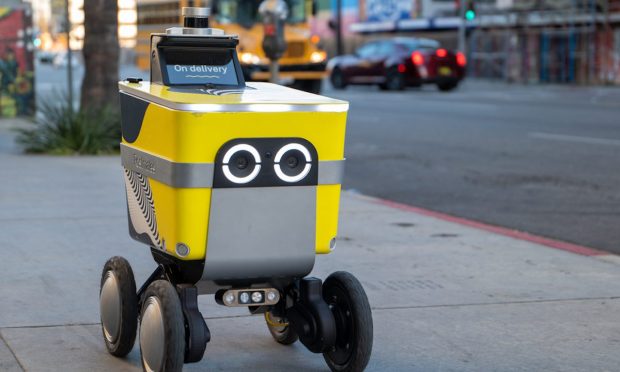Uber-Backed Robotics Startup Predicts Autonomous Food Delivery Will Be in All Major Cities Within Five Years

Consumers want food delivery faster and more frequently than ever, but the economics still do not work. With leading services raising prices from their initial venture capital-subsidized rates and yet still typically failing to make a profit, with customers growing frustrated with rising costs, and with restaurants struggling to afford these services’ commissions, something needs to give. Now, robotics companies are stepping in, promising to solve the problem by cutting labor costs with automation.
“The demand is rising — people want things faster, and they want it cheaper,” Ali Kashani, co-founder and CEO of Serve Robotics, told PYMNTS in an interview. “It’s just not sustainable. The way we are doing the deliveries today, relying on one human being having to move one burrito to its final destination … It’s just not going to scale. It’s not good for the cities. It’s not good for the environment, and it’s not good for the restaurants and merchants. I think it’s a perfect time for the robots to step in and help with this problem.”
Investors are getting onboard, with funds pouring in for a range of different robotic and autonomous delivery startups. Earlier this month, Serve Robotics, which began as the robotics arm of Postmates and spun off in February in a bid to secure a wider range of strategic partners, announced a $13 million seed funding round with participation from a range of high-profile businesses, including 7-Eleven and Postmates parent company Uber.
Read more: Postmates’ Serve Closes $13M Round to Increase Delivery Robots
Big Savings
With Serve Robotics having completed tens of thousands of deliveries in Los Angeles and San Francisco, with Chipotle-backed autonomous vehicle startup Nuro piloting its deliveries in several states, and with autonomous delivery startup Ottonomy partnering with restaurant technology company Presto to automate curbside drop-off, among other developments, there is a lot of movement in the space.
If these early efforts prove successful and scalable, the opportunity is huge for those in the space. Research from PYMNTS’ study “The Bring-It-to-Me Economy: How Online Marketplaces And Aggregators Drive Omnichannel Commerce,” created in collaboration with Carat from Fiserv — which featured a census-balanced survey of more than 5,200 U.S. consumers — finds that 58% of consumers are ordering restaurant food online more often than prior to March 2020, with 48% of restaurant customers ordering from restaurants’ websites for home delivery more often and 46% ordering more from aggregators.
See also: Bring-It-to-Me Economy Ascends as Consumers Embrace Home-Centric Lifestyles
“Today, it costs $2 to get something from China to the U.S., but it costs $10 to get something from Chinatown to your front door,” Kashani said, noting that long-haul shipping has seen productivity increase by five orders of magnitude in the last century. “But then you look at last-mile … [it] has become twice as productive … it’s not even a single order of magnitude.”
For Serve’s part, its robots are operated by a remote driver who can manage multiple deliveries at once, cutting down on the cost of each drop-off.
Sidewalks, Streets and Skies
As Kashani explains it, the sidewalk robot model gained traction after people began to realize that the timeline for self-driving cars would be longer than initially expected, prompting a shift from developing autonomous solutions to move people at high speeds to solutions that can move goods at lower speeds, turning the focus from the street to the curb.
“You’re seeing a lot of traction with things like sidewalk delivery, because it commercializes autonomy now,” he said.
Meanwhile, sidewalk robots such as those created by Serve and autonomous road-driving vehicles such as Nuro’s are not the only automated devices entering the food delivery space. Drone delivery companies such as Flytrex and Drone Express are also making moves to cut labor costs from food delivery.
However, Kashani argues that drones are not a threat. Instead, he predicts that sidewalk robots will be widely implemented in cities, while drones will be more useful in suburban or rural areas with less dense populations.
“Delivery is multimodal — you’re always going to have different vehicles for different types of deliveries,” he said. “So, drones are going to be part of the solution. Robots are going to be another part of the solution.”
More Places, More Use Cases
Kashani argued that we are at a turning point such that within five years, robotic delivery will be far more widely available.
“I would expect to see robots in every major city,” he said. “This is the moment that scale-up is happening.”
Additionally, the space may grow not only geographically, but also in terms of use cases, Kashani said, commenting on Ottonomy’s pilot of automated curbside drop-off. Where initial tests of sidewalk robots for food delivery involved transporting food from restaurants to consumers’ doors, there remain more possibilities.
“There are multiple steps [in food delivery]: to the curb, to the home, and then from the home up to the front door,” he noted. “There could be different ways robots are used every step of the way. It’s going to be really fun watching the market experiment with different ideas over the next few years.”
